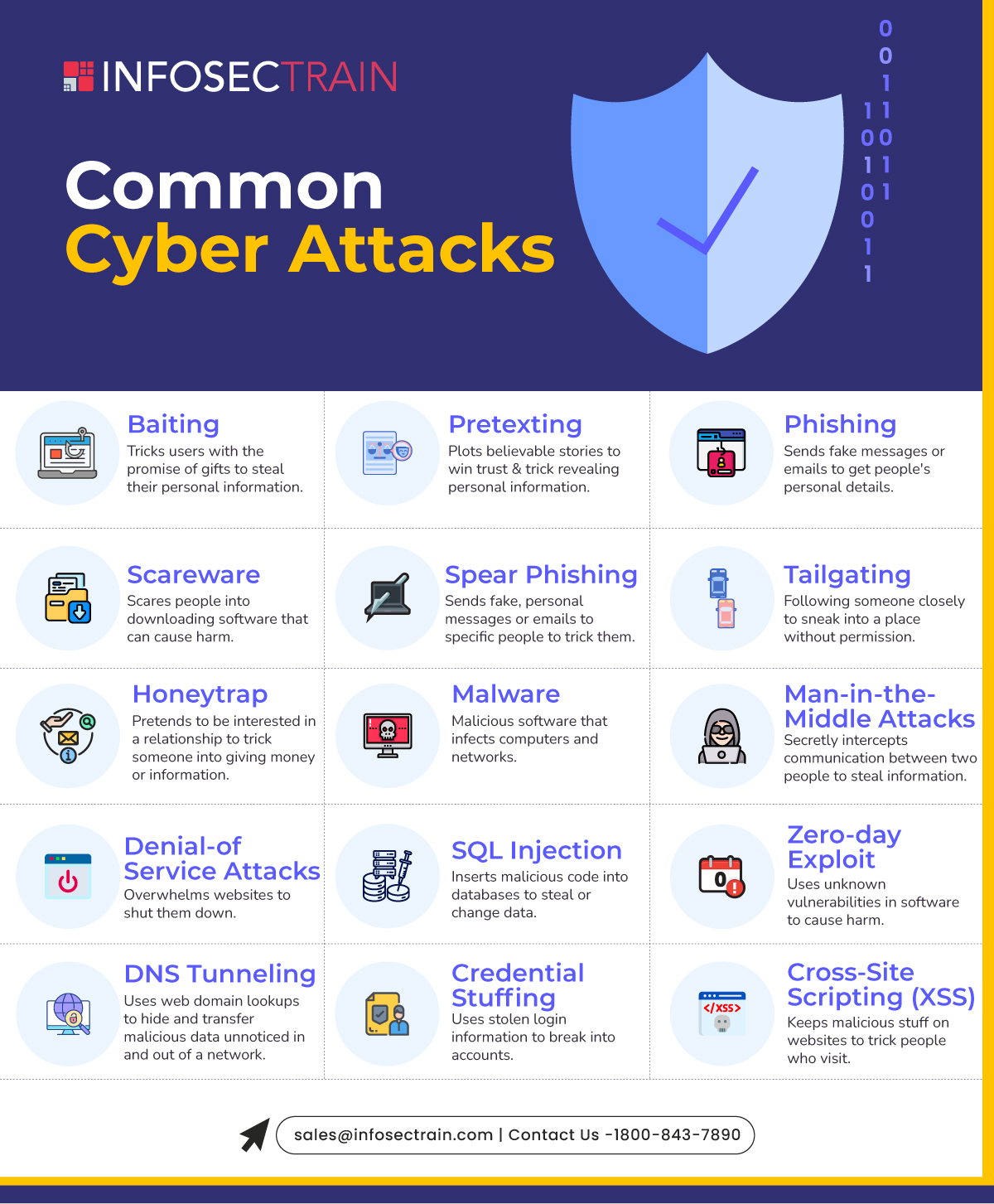How to Prevent the Most Common Cyber Attacks?
As we rely more on the internet, cyber attacks become more common. These attacks, which range from simple annoyances to major threats, can lead to theft, fraud, or significant disruption to personal and business activities. In this article, we’ll break down the 15 most common cyber attacks and see how to prevent them.

Table of Contents
What is a Cyber Attack?
15 Most Common Cyber Attacks
How to Prevent Common Cyber Attacks?
What is a Cyber Attack?
A cyber attack is when attackers try to infiltrate your computer or network to steal data, cause damage, or disrupt operations. It often starts with unauthorized access, leading to more severe attacks on data or systems. The primary goal of these attacks is usually to access, change, or destroy sensitive information, extort money from users, or interrupt normal business processes.
15 Most Common Cyber Attacks
Understanding these cyber attacks and their methods is crucial. Once you grasp how they work, it becomes much easier to detect and prevent them. Here are the 15 most common cyber attacks.

1. Baiting: Imagine a trap where the bait is a free movie or game. Cyber attackers use these fake promises to trick you into giving away your details or downloading software that harms your computer. This is baiting which also occurs in physical forms, such as through the use of a malware-infected flash drive given to users.
2. Pretexting: In pretexting, attackers construct believable stories to win your trust, only to trick you into revealing personal information. They might pretend to be conducting a survey that asks for sensitive information like your bank details.
3. Phishing: Phishing is a common attack method that involves sending emails or messages that look like they’re from legitimate sources. The goal is to deceive you into revealing login credentials or credit card numbers.
4. Scareware: In a scareware attack, Attackers send alarming messages claiming that your computer is infected with a virus to compel you to do something against your sense of right and wrong or scare you into buying software that you don’t need or that could actually be malicious.
5. Spear Phishing: Spear-phishing is a more personalized form of phishing where the attacker chooses specific individuals and sends them customized messages, making the scam seem more legitimate to steal sensitive information.
6. Tailgating: An attacker physically follows someone into a secured area without proper authorization. They exploit moments when someone else opens a secured door and slips in unnoticed.
7. Honeytrap: Attackers create fake online profiles and engage in relationships to manipulate people into sending money or sharing private information.
8. Malware: Malware is malicious software deliberately created to damage computers, servers, or networks and includes viruses, trojans, adware, and worms.
9. Man-in-the-Middle Attacks: During a man-in-the-middle attack, the perpetrator secretly relays and possibly intercepts the communication between two parties who think they are directly communicating with each other.
10. Denial-of-Service Attacks: These attacks involve overwhelming a system’s resources, making it unable to respond to service requests, and causing a network to crash.
11. SQL Injection: This attack exploits vulnerabilities in data-driven applications by injecting malicious SQL code that can be used to manipulate the database, allowing information to be read, altered, or deleted.
12. Zero-day Exploit: Zero-day exploit attacks occur when attackers exploit a newly discovered vulnerability in software before the developers can create a patch to fix it.
13. DNS Tunneling: This technique uses DNS queries, which are normally used for locating domain names, to sneakily pass undetected data through a firewall.
14. Credential Stuffing: Attackers use stolen account credentials (like usernames and passwords) and automate attempts to log in to other websites with the same credentials, hoping that people have reused them.
15. Cross-Site Scripting (XSS): In cross-site scripting (XSS) attacks, cybercriminals inject malicious scripts into trusted websites. When users visit these websites, the scripts can steal data directly from their browsers.
How to Prevent Common Cyber Attacks?
Individual users should keep the following tips in mind when receiving information from an unfamiliar, unconventional, or mysterious source.
Tips for Individual Users:
| Do | Do not |
| Check the validity of the source | Click on a link or download files from someone you do not know or who appears suspicious |
| Update and repair your operating system and apps regularly | Reveal your personal details like login credentials and credit card details |
| Install a pop-up defender and spam filter, buy security software, and only go to URLs that start with HTTPS | Plug a USB or other unknown device into your computer |
| Implement multi-factor authentication, utilize a password manager, and sign in through your account or the official website | Give someone else access to your accounts or devices |
Tips for Organizational Users:
- Educate your employees on cybersecurity best practices
- Ensure the operating system and other software are updated with current security patches
- Constantly scan the environment for malicious activity
- Include threat intelligence in your security strategy
Cybersecurity with InfosecTrain
There’s a lot to learn about cyber attacks and cybersecurity, and gaining extensive knowledge is crucial. InfosecTrain provides a range of courses, including CEH and CompTIA Security+, designed to enhance your cybersecurity skills and knowledge. Whether you are already working in the field or are keen to expand your expertise, continuous education is invaluable. The more proficient you are in cybersecurity, the more effectively you can perform in your role, improving your career opportunities whether you plan to progress in your current job or transition to a new one. Discover more about cybersecurity by exploring the courses offered by InfosecTrain.
TRAINING CALENDAR of Upcoming Batches For CEH v12
| Start Date | End Date | Start - End Time | Batch Type | Training Mode | Batch Status | |
|---|---|---|---|---|---|---|
| 02-Jun-2024 | 13-Jul-2024 | 09:00 - 13:00 IST | Weekend | Online | [ Open ] | |
| 06-Jul-2024 | 11-Aug-2024 | 19:00 - 23:00 IST | Weekend | Online | [ Open ] |




 1800-843-7890 (India)
1800-843-7890 (India) 
